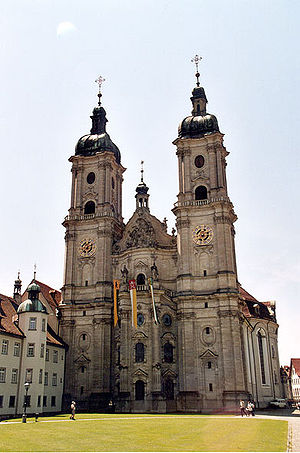Abbey of Saint Gall
Imperial Abbey of St Gall Reichsabtei Sankt Gallen | |||||||||
|---|---|---|---|---|---|---|---|---|---|
| 1207–1798 | |||||||||
 The Imperial Abbey shown in green and pink on this map of the lands of the canton of St Gallen | |||||||||
| Status | Imperial Abbey of the Holy Roman Empire | ||||||||
| Capital | St Gallen | ||||||||
| Government | Theocracy | ||||||||
| Historical era | Middle Ages | ||||||||
• Abbey founded | 613 | ||||||||
• Gained Reichsfreiheit | 1207 | ||||||||
• Became Swiss protectorate | August 17 1451 | ||||||||
• Pillaged by the Swiss | 1712 | ||||||||
| 1798 1798 | |||||||||
| 1803 | |||||||||
| |||||||||
| UNESCO World Heritage Site | |
|---|---|
 | |
| Criteria | Cultural: ii, iv |
| Reference | 268 |
| Inscription | 1983 (7th Session) |
The Abbey of St. Gall (German: Sankt Gallen) was for many centuries one of the chief Benedictine abbeys in Europe. It is located in the city of St. Gallen in present-day Switzerland.
History
The monastery was founded in 613 and named after Gallus, an Irishman. Saint Gallus was a disciple and companion of Saint Columbanus, and died there in 646.
Charles Martel appointed a certain Othmar as a custodian of St Gall's relics. During the reign of Pepin the Short Othmar founded the famous schools of St. Gall, where arts, letters and sciences flourished. Under Abbot Waldo of Reichenau (740-814) copying manuscripts was undertaken and a famous library was gathered. Numerous Anglo-Saxon and Irish monks came to copy manuscripts. At Charlemagne's request Pope Adrian I sent distinguished chanters from Rome, who propagated the use of the Gregorian chant.
In the subsequent century, St. Gall came into conflict with the nearby Abbey of Reichenau on Lake Constance. Between 924 and 933 the Magyars threatened the abbey and the books had to be removed to Reichenau for safety. Most were later returned.
In the 13th century, the abbey and the town became an independent principality, over which the abbots ruled as territorial sovereigns ranking as Princes of the Holy Roman Empire.
Under abbot Pius (1630–74) a printing press was started. In 1712, a great change came to St. Gall with the pillage by the Swiss. Most of the books and manuscripts were taken by them to Zürich and Bern. After confusion and suppression and rearrangements St. Gall became the residence of the bishop and held the offices of the Canton, along with the remains of the library.
Little remains of the medieval monastery now. Most of existing structures, including the cathedral, were designed in the late Baroque style and constructed between 1755 and 1768.
Cultural treasures
The library at St. Gall is recognised to be one of the richest medieval libraries in the world. It is home to one of the most comprehensive collections of early medieval books in the German-speaking part of Europe. As of 2005, the library consists of over 160,000 books whereof 2200 are handwritten and 500 are over 1000 years old. Lately the Stiftsbibliothek has launched a project for the digitisation of the priceless manuscript collection.
The library also preserves a unique 9th-century document, known as the Plan of St. Gall, the only surviving major architectural drawing from the roughly 700-year period between the fall of the Roman Empire and the 13th century. The Plan drawn was never actually built, and was so named because it was kept at the famous medieval monastery library, where it remains to this day. The plan was an ideal of what a well-designed and well-supplied monastery should have, as envisioned by one of the synods held at Aachen for the reform of monasticism in the Frankish empire during the early years of emperor Louis the Pious (between 814 and 817).
In 1983, the Convent of St. Gall was inscribed on the UNESCO World Heritage List as "a perfect example of a great Carolingian monastery".
Gallery
-
The interior of the Cathedral is one of the most important baroque monuments in Switzerland
-
Abbey Library of St. Gall
-
Abbey of St. Gall at night
External links
 "Abbey of St. Gall" in the 1913 Catholic Encyclopedia.
"Abbey of St. Gall" in the 1913 Catholic Encyclopedia.- Stiftsbibliothek Sankt Gallen
- Codices Electronici Sangallenses — project for the digitisation of the medieval manuscripts at Sankt Gallen




